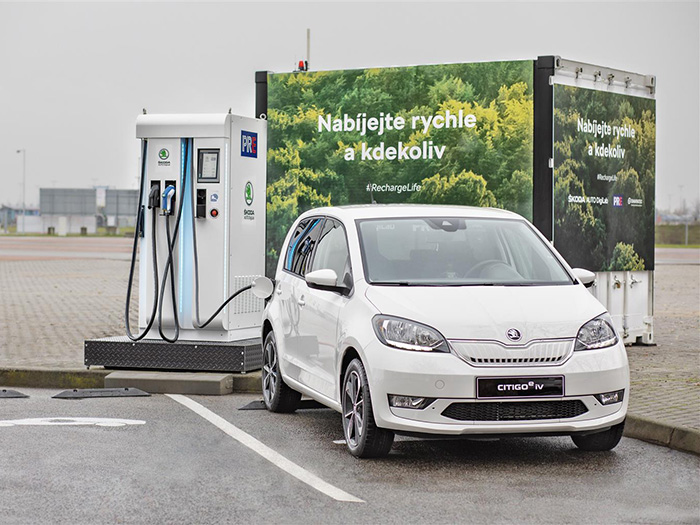Kinetic Power Booster - flywheel technology for rapid charging
ŠKODA AUTO DigiLab has started a pilot project in Prague. The technology enables the system to get twice as much electricity as the national grid can supply and the fast-charging points can be installed even in places where there is ordinarily insufficient power.
Fast-charging stations play a crucial role in driving the spread of e-mobility as they allow cars to be used for longer distances, without making any sacrifices. Volkswagen Group is directly involved in the installation of charging points and in rolling out the infrastructure.
As part of this, ŠKODA AUTO DigiLab has started a pilot project in order to test an innovative fast-charging station that uses kinetic flywheel technology and provides twice as much electric power as the national grid can supply.
The charging point at the Prague Exhibition Centre in Letňany is the first of its kind in the Czech Republic and only the third in the world. The charging technology was developed by the Israeli start-up Chakratec. The company was discovered and brought on board by ŠKODA AUTO DigiLab Israel to develop innovative mobility solutions.
“The collaboration with Chakratec shows how innovative ideas can be turned into concrete projects. With our decision to trial the first Kinetic Power Booster in Prague, we are demonstrating that ŠKODA is consistently working on a comprehensive range of services for our customers in terms of e-mobility”, said Andre Wehner, Chief Digital Officer at ŠKODA AUTO.
Flywheel energy

Chakratec has developed the Kinetic Power Booster, a system that makes it possible to supply fast-charging technology, even where there is ordinarily insufficient power. The system is designed to absorb peak loads in the grid that it is connected to, accelerating its flywheels to high speeds and storing the electricity as kinetic energy.
When an electric car is then connected to the charging station, the Kinetic Power Booster releases this as electricity, and doubles the charging power that the national grid could have provided on its own. In contrast to battery-based charging stations, the capacity remains the same at all times. What’s more, the purely mechanical flywheel technology is remarkably eco-friendly as it does not make use of chemical battery cells.
20 years of recharging
The Kinetic Power Booster’s technical centrepiece is the ten flywheels housed in a container, where they rotate in a vacuum in order to keep the movement generated by electricity supplied by the grid constant. As soon as a vehicle is connected to be recharged, the flywheels generate additional electricity themselves, slowing down in the process. Once a car’s battery has been topped up, the flywheels need time to return to their operating speed – for the station in Prague, which can generate 100 kW, this takes about 45 minutes.
Every charging station based on this system allows for around 200,000 fast-charge and discharge cycles. This corresponds to a lifespan of about 20 years. The Kinetic Power Booster has been designed to be installed initially in car dealerships or shopping centres, but it has potential for a wide range of applications. In this initial launch and test phase in Prague users can recharge their cars for free. Prices and payment methods as well as a possible rollout in other countries will be announced at a later date.
Source: ŠKODA Auto
